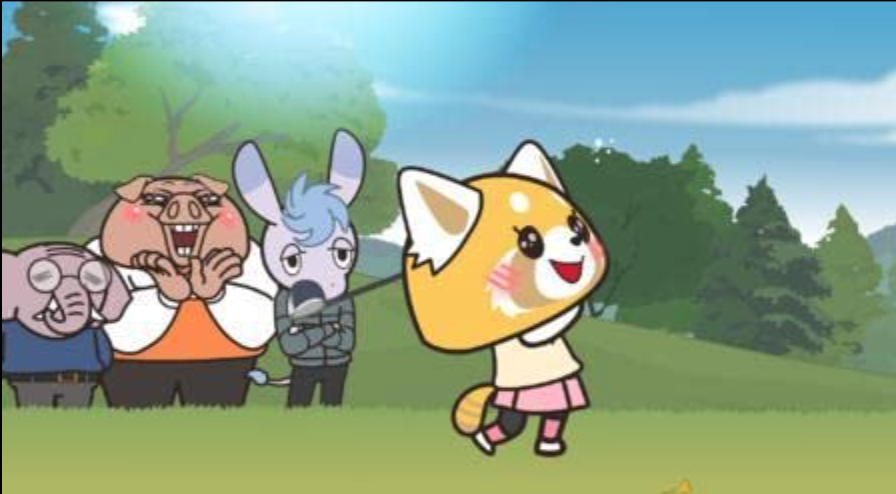Animated: Come to the dark side with ‘Aggretsuko’

The other day, I changed my Netflix profile icon to one of Retsuko, the red panda from the Netflix television series “Aggretsuko.” I changed it because I recently finished watching the show, but mostly because I felt like the angry, screeching Retsuko was the best representation of my mood at the moment.
If you’re not familiar with the Netflix Japanese anime series created by Rarecho, “Aggretsuko” is about a red panda named Retsuko who has a secret.
Although she appears as a good-natured, passive office lady on the outside, Retsuko actually turns into a sort of alter ego when she’s singing death metal karaoke, which is the only way she can effectively express her real feelings. (How I initially thought about it: Hannah Montana, but the red panda version.)
The setting is modern Japanese society with a catch: All of the characters, like Retsuko, are animals. These animals have exaggerated traits and are almost caricature-like. They’re intended to represent real personalities, particularly those in the office. The “traits” of each animal consequently define the character.
What I think is so appealing about “Aggretsuko” is how the show distills these real-life dynamics into adorable Sanrio characters. Their cuteness and humor simultaneously distances us from these characters, while still seriously recognizing the archetypes in our life they represent.
Retsuko has two faces, literally. She has the pleasant, smiling face that shapes her treatment in the office and her aggressive, death metal makeup face reserved for her karaoke sessions.
Even if we’re not red pandas, I think we can all relate to having two different sides of ourselves. Unintentionally or not, there are also aspects of myself that I need to suppress to conform to socially accepted behaviors.
Like Retsuko, I have a difficult time expressing honestly how I feel about certain things, and I tend to believe others don’t understand me.
Commentators have viewed Retsuko as a feminist emblem, writing that Retsuko’s inability to let out her anger represents how society at large often expects women to hide their emotions; at the same time, men can freely express how they feel.
Marley Crusch at The Dot and Line writes that “Aggretsuko” and its relatable depiction of rage taught her how important it was that she “reclaim” her own.
In analyzing the show’s feminist themes, Crusch mentions that women supporting women frequently comes up throughout the series. Retsuko’s friendships with Gori and Washimi, two women who are higher-ups at the office, are heartening as they support her in all sorts of matters, from relationship problems to her workplace troubles.
In addition to being iconic for women worldwide, “Aggretsuko” is also an apt reflection of Japanese corporate society, especially the cultural need to conform to expectations. For that reason, BBC labeled Retsuko as “Japan’s new working woman,” as her character resonated with many women for being two-sided, breaking the convention: simultaneously cute and angry.
It’s funny that Retsuko often launches into angry tirades against individuals that irritate her by screaming her feelings through death metal.
It’s also incredibly relatable — how many times have we just smiled in favor of social politeness when we’re seething with rage inside? Who doesn’t have that internal monologue that we often don’t get to say out loud?
“Aggretsuko” is special because it’s so mundane. The scenarios feel deeply personal, even if they’re not universal. Unlike Retsuko, I don’t go out at night to sing death metal karaoke and unleash my rage. Yet, I think we all need an outlet for the emotions that we find difficult to express. We maintain different versions of ourselves to others. Like Retsuko, we might have to figure out how to navigate workplace bosses that might not like us. We might be afraid to show our “real” selves to others.
Within the context of an anthropomorphic society, Retsuko represents the everygirl. “Aggretsuko” takes viewers through workplace politics, different romantic relationships and relatable situations. There’s a brief stint where Retsuko even becomes a Japanese pop idol, but all of her struggles are deeply rooted in ideas of visibility and invisibility.
Even as Retsuko becomes an idol and struggles with a dangerous hater, rage is a central part. Retsuko wonders if she can withstand the rage of others when a side of herself doesn’t conform to their ideal image.
At its heart, the show feels like it’s about peeling away the layers of yourself. You don’t need a microphone to scream and fully say what you feel. But, sometimes, we need to let that part of ourselves out.
Valerie Wu is a junior writing about animation from a contemporary perspective. Her column “Animated” runs every other Friday.

